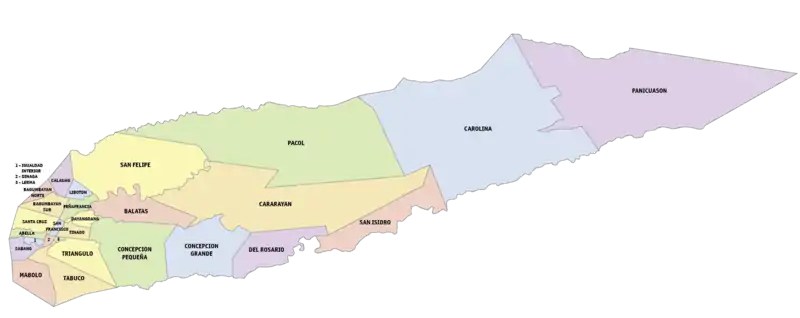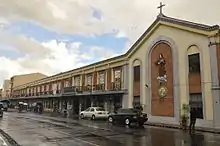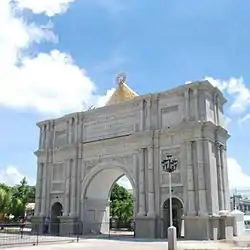Naga, Camarines Sur
Naga, officially the City of Naga (Central Bikol: Ciudad nin Naga; Rinconada Bikol: Syudad ka Naga; Tagalog: Lungsod ng Naga; Spanish: Ciudad de Naga), is a 2nd class independent component city in the province of Camarines Sur, Philippines. It is also the third oldest royal city in the country.[6] According to the 2015 census, it has a population of 196,003 people. [4]
Naga
Nueva Caceres | |
|---|---|
| City of Naga | |
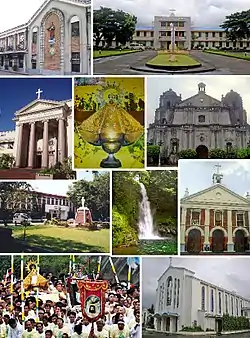 (From top, left to right) Holy Rosary Seminary, Universidad de Santa Isabel, Naga Metropolitan Cathedral, Our Lady of Peñafrancia, Ateneo de Naga University, Our Lady of Peñafrancia Shrine, Malabsay Falls, Naga City Hall, Carmelite Monastery, Peñafrancia Festival | |
 Seal | |
Nickname(s):
| |
| Motto(s): Uswag, Naga! (Progress, Naga!) | |
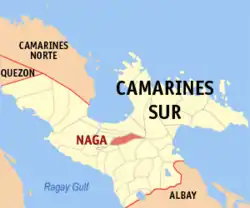 Map of Camarines Sur with Naga highlighted | |
OpenStreetMap 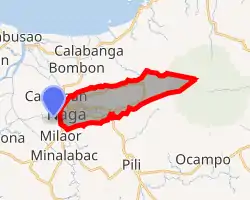
| |
.svg.png.webp) Naga Location within the Philippines | |
| Coordinates: 13°37′N 123°10′E | |
| Country | Philippines |
| Region | Bicol Region (Region V) |
| Province | Camarines Sur (geographically only) |
| District | 3rd district |
| Founded (as Nueva Caceres) | 1575 |
| Royal City-Charter | 1595 |
| Renamed as Naga | 1919 |
| Cityhood | June 18, 1948 |
| Founded by | Capt. Pedro de Chavez |
| Barangays | 27 (see Barangays) |
| Government | |
| • Type | Sangguniang Panlungsod |
| • Mayor | Nelson S. Legacion[2] |
| • Vice Mayor | Cecilia V. De Asis[2] |
| • Representative | Gabriel H. Bordado Jr. |
| • Electorate | 105,366 voters (2019) |
| Area | |
| • Total | 84.48 km2 (32.62 sq mi) |
| Elevation | 66 m (217 ft) |
| Population | |
| • Total | 196,003 |
| • Density | 2,300/km2 (6,000/sq mi) |
| • Households | 41,280 |
| Demonym(s) | Nagueño (masculine) Nagueña (feminine) Nagueñians (English, unofficial) |
| Economy | |
| • Income class | 2nd city income class |
| • Poverty incidence | 19.29% (2015)[5] |
| • Revenue | ₱975,090,393.23 (2016) |
| Time zone | UTC+8 (PST) |
| ZIP code | 4400 |
| PSGC | |
| IDD : area code | +63 (0)54 |
| Climate type | tropical rainforest climate |
| Native languages | Central Bikol Inagta Partido Tagalog |
| Website | naga |
The town was established in 1575 by order of Spanish Governor-General Francisco de Sande. The city, then named Ciudad de Nueva Cáceres (New Cáceres City), was the third Spanish royal city in the Spanish East Indies, after Iloilo and Manila.
Geographically and statistically classified, as well as legislatively represented within Camarines Sur, but administratively independent of the provincial government, Naga is the Bicol Region's trade,[7][8] business,[8] religious, cultural, industrial, commercial,[9] medical,[10][11] educational,[9][12] and financial center.[13][14][15][16][17][18]
Naga is known as the "Queen City of Bicol",[19] and as the "Heart of Bicol",[20][21] due to its central location on the Bicol Peninsula; and as the "Pilgrim City" because Naga is also the destination of the largest Marian pilgrimage in Asia, the Our Lady of Peñafrancia, whose image is one of the most popular objects of devotion in the country.[22] Naga is also known as "One of the Seven Golden Cities of the Sun" as stated by Nick Joaquin.[23]
The city is the seat of the metropolitan Roman Catholic Archdiocese of Caceres, whose jurisdiction includes all the suffragan sees of Bicol.
It is one of the two Philippine cities named Naga, the other being Naga in Cebu.
History
Precolonial era
The region of Bicol was closely allied with the Kedatuan of Madja-as confederation, which was located on Panay island. According to the Maragtas, two datus and their followers, who followed Datu Puti, arrived at Taal Lake, with one group later settling around Laguna de Bay, and another group pushing southward into the Bicol peninsula, placing the Bicolanos between people from Luzon and people from the Visayas. An ancient tomb preserved among the Bicolanos, discovered and examined by anthropologists during the 1920s, refers to some of the same deities and personages mentioned in the Maragtas.[24]
Spanish colonial period
In 1573, on his second expedition to this region, the conquistador Juan de Salcedo landed in a village and named it Naga because of the abundance of narra trees (naga in Bikol).
In 1575, Captain Pedro de Chávez, the commander of the garrison left behind by Salcedo, founded on the site of the present business centre (across the river from the original Naga) a Spanish city which he named La Ciudad de Cáceres, in honor of Francisco de Sande, the governor-general and a native of the city of Cáceres in Spain. It was by this name that it was identified in the papal bull of August 14, 1595, which established the see of Cáceres, together with those of Cebú and Nueva Segovia, and made it the seat of the new bishopric under the archdiocese of Manila.
In time, the Spanish city and the native village merged into one community and became popularly known as Nueva Cáceres, to distinguish it from its namesake in Spain. It had a city government as prescribed by Spanish law, with an ayuntamiento and cabildo of its own. At the beginning of the 17th century, there were only five other ciudades in the Philippines. Nueva Cáceres remained the capital of the Ambos Camarines provinces and later of the Camarines Sur province until the formal creation of the independent chartered city of Naga under the Philippine Republic.
For hundreds of years during the Spanish colonial era, Naga grew to become the center of trade, education, and culture, and the seat of ecclesiastical jurisdiction in Bicol.
American colonial period
With the advent of American rule, the city was reduced to a municipality. In 1919, it lost its Spanish name and became officially known as Naga.
World War II and Japanese occupation
Naga came under Japanese occupation on December 18, 1941, following the Japanese invasion of Legaspi a few days earlier.[25]
In 1945, toward the end of World War II, combined U.S. and Philippine Commonwealth troops—of the United States Army, Philippine Commonwealth Army, Philippine Constabulary, as well as Bicolano guerrilla resistance groups—liberated Naga from imperial Japanese troops.
Independent Philippines
After Naga was liberated from the Japanese, Naga began rebuilding. Having suffered only a few casualties, Naga was able to rebuild quickly after the war. After many petitions, Naga became a city on June 18, 1948, when it acquired its present city charter; and its city government was inaugurated on December 15 of the same year by virtue of Republic Act No. 305.[26]
Geography
Naga is located within the province of Camarines Sur at the southeastern tip of Luzon, 435 kilometres (270 mi) southeast of Manila, the nation's capital, and near the center of the Bicol Region. It is surrounded on all sides by forests and by rich agricultural and fishing areas. It has an area of 8,448 hectares (20,880 acres) and is located on the serpentine and historic Naga River, at the confluence of the Naga and Bikol rivers. Thus, it has always been an ideal place for trade, and as center for schools, church, and government offices. Included in its territory is Mount Isarog, a declared protected area known as Mount Isarog Natural Park.[27]
Climate
According to the Köppen climate classification system, Naga has a tropical savanna climate.
The weather in the city from March to May is hot and dry, with temperatures ranging from 24 to 34 °C (75 to 93 °F). The typhoon season is from June to October, and the weather then is generally rainy. From November to February, the climate is cooler with temperatures ranging from 22 to 28 °C (72 to 82 °F). The average year-round humidity is 77%.[28]
| Climate data for Naga | |||||||||||||
|---|---|---|---|---|---|---|---|---|---|---|---|---|---|
| Month | Jan | Feb | Mar | Apr | May | Jun | Jul | Aug | Sep | Oct | Nov | Dec | Year |
| Average high °C (°F) | 30.2 (86.4) |
31.1 (88.0) |
32.8 (91.0) |
34.3 (93.7) |
34.2 (93.6) |
32.4 (90.3) |
31.3 (88.3) |
30.8 (87.4) |
31.1 (88.0) |
31.2 (88.2) |
31.0 (87.8) |
30.3 (86.5) |
31.7 (89.1) |
| Daily mean °C (°F) | 25.6 (78.1) |
26.1 (79.0) |
27.6 (81.7) |
29.1 (84.4) |
29.5 (85.1) |
28.4 (83.1) |
27.7 (81.9) |
27.4 (81.3) |
27.6 (81.7) |
27.3 (81.1) |
26.9 (80.4) |
26.0 (78.8) |
27.4 (81.4) |
| Average low °C (°F) | 20.9 (69.6) |
21.1 (70.0) |
22.5 (72.5) |
24.0 (75.2) |
24.8 (76.6) |
24.4 (75.9) |
24.1 (75.4) |
24.0 (75.2) |
24.0 (75.2) |
23.5 (74.3) |
22.8 (73.0) |
21.6 (70.9) |
23.1 (73.6) |
| Average precipitation mm (inches) | 6.3 (0.25) |
3.3 (0.13) |
7.1 (0.28) |
9.3 (0.37) |
100.4 (3.95) |
272.7 (10.74) |
341.2 (13.43) |
398.3 (15.68) |
326.0 (12.83) |
230.0 (9.06) |
120.4 (4.74) |
48.8 (1.92) |
1,863.8 (73.38) |
| Average rainy days | 1.0 | 1.0 | 1.0 | 1.0 | 7.0 | 14.0 | 16.0 | 19.0 | 17.0 | 13.0 | 9.0 | 5.0 | 104 |
Barangays
Naga is politically subdivided into 27 barangays.[29]
| Barangays | Class | Population[30] | Barangay head[31] |
|---|---|---|---|
| Abella | Urban | 4,788 | Eduardo Albo |
| Bagumbayan Norte | Urban | 2,991 | Dodit Beltran |
| Bagumbayan Sur | Urban | 6,959 | Jorge I. Salva Jr. |
| Balatas | Urban | 10,404 | Pedro San Juan Jr. |
| Calauag | Urban | 11,513 | Corazon Peñaflor |
| Cararayan | Urban | 15,998 | Rodrigo B. Agravante Jr. |
| Carolina | Urban | 5,841 | Alicia V. Saba |
| Concepcion Grande | Urban | 11,137 | Leticia Punzalan |
| Concepcion Pequeña | Urban | 23,577 | Jewelin G. Regmalos |
| Dayangdang | Urban | 4,568 | Joshua Calleja |
| Del Rosario | Urban | 9,332 | Gina Alcantara |
| Dinaga | Urban | 456 | Gemma Joy Antonio |
| Igualdad Interior | Urban | 3,379 | Domingo Alamer |
| Lerma | Urban | 2,337 | Domingo Serrado |
| Liboton | Urban | 3,075 | Salvadora Ortua |
| Mabolo | Urban | 7,611 | Magno Reyes |
| Pacol | Urban | 11,673 | Josue Perez |
| Panicuason | Urban | 2,715 | Domingo Ramos |
| Peñafrancia | Urban | 5,712 | Jeffrey Moralde |
| Sabang | Urban | 7,000 | Cyrus Caballero |
| San Felipe | Urban | 17,444 | Alfonso Rodriguez |
| San Francisco | Urban | 947 | Tomas Ramon Sanchez Jr. |
| San Isidro | Urban | 2,768 | Veronica C. Panganiban |
| Santa Cruz | Urban | 7,442 | Lorenzo D. Narvaez |
| Tabuco | Urban | 4,129 | Marcelo R. Bagadiong |
| Tinago | Urban | 3,268 | Jose Importante |
| Triangulo | Urban | 9,019 | Allan Beriso |
Demographics
|
| ||||||||||||||||||||||||||||||||||||||||||||||||
| Source: Philippine Statistics Authority [4] [32] [33][34] | |||||||||||||||||||||||||||||||||||||||||||||||||
Religion
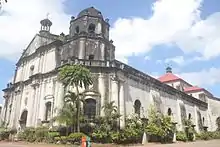
Roman Catholicism
The city is the ecclesiastical seat of the Archdiocese of Caceres, which oversees the Catholic population in the Bicol Region, whose archbishop is the primate of the region. This dominant faith is supported by the presence of old and influential Catholic institutions, from universities to churches run by different religious institutes, notably the Ateneo de Naga University by the Jesuits; the Universidad de Santa Isabel by the Daughters of Charity; the Naga Metropolitan Cathedral, which is the oldest cathedral that is still standing in Luzon outside Metro Manila; Peñafrancia Basilica Minore, which is the largest Catholic structure in southern Luzon in terms of size and land area; Our Lady of Peñafrancia Shrine; the historic San Francisco Church; and Peñafrancia Museum.
Other Christian faiths
Protestant denominations in the city include Seventh-day Adventists and Bible Baptists, whose churches are located along Magsaysay Avenue, while other Protestants attend the Methodist Church which is among the old structures along Peñafrancia Avenue.
The Assemblies of God maintains a fast-growing ministry in Naga. Aside from Naga Bethel Church (formerly Naga Bethel Temple), which is located on Felix Plazo Street, other local congregations are Philippians Christian Fellowship (in barangays San Felipe), Gethsemane Christian Ministries (in Carolina), and outreach ministries in other barangays.
The largest minority religion in Naga is Iglesia ni Cristo (INC). INC has several chapels in different barangays in the city, and the local congregation is the largest in the district.
There is also a concentration of Jesus Miracle Crusade ministries in the city.
Other religions
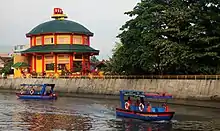
Language
The Coastal Bikol-Central dialect of the Coastal Bikol language is the dominant dialect spoken by the population in Naga.[35] Central Standard Bikol is also the basis for other dialects in the Bicol Region.[36] The majority of the city's population can understand and speak English, Filipino, and Tagalog. Because of the influx of people from the Rinconada area that are studying in different universities, Rinconada Bikol can also be heard in different schools and throughout the city. Some Nagueños have varying degrees of proficiency with Rinconada Bikol, due to the fact that the southern half of Pili, which is the boundary between Rinconada Bikol and Coastal Bikol speakers, is just few kilometers away from Naga. Although the main language is Bikol, and the medium of instruction in school is English, people in Naga usually tell time and count in Spanish.
Isarog Agta Language
In 2010, UNESCO released its 3rd volume of Atlas of the World's Languages in Danger, where three critically endangered languages were in the Philippines. One of these is the Isarog Agta language, of the Isarog Agta people, who live on Mount Isarog and are one of the original Negrito settlers in the Philippines, belonging to the Aeta people classification but with language and belief systems unique to their own culture and heritage.
Only five Isarog Agta spoke their indigenous language in the year 2000. The language was classified as "Critically Endangered", meaning the youngest speakers are grandparents and older, speak the language partially and infrequently, and hardly pass the language to their children and grandchildren. If the remaining 150 Isarog Agta do not pass their native language to the next generation, it will be extinct within one to two decades.
Economy

Naga is the Bicol Region's center of commerce and industry.[18] Strategically located at the heart of Bicol, Naga is the trade center in Bicol for goods from Visayas and Manila.
Naga is cited as one of the "Most Business-Friendly Cities in Asia", is considered to be one of the Philippines's Top-10 cities, and is a "most competitive city" of the Philippines.[37][38] Some entrepreneurs cited the city as the most business-friendly in the region.[39]
Business districts
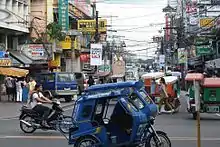
Downtown Naga is located in the southern part of the city. It is bordered, on the north, by the Naga University Belt and, on the south, by the historical Naga City Peoples Mall or simply Naga City Community Supermarket. It encompasses the three plazas of Naga: The Plaza Quince Martires, The Plaza Quezon, and the Plaza Rizal, which is the center of Central Business District 1 (CBD-1). Downtown Naga is the location of local businesses that sell local delicacies and native products from neighboring municipalities and provinces.
A second business district is located along Panganiban Drive, and Roxas, Ninoy and Cory avenues. It is also the location of 3 shopping complexes, a bus terminal,[40] and the Camarines Sur Industrial and Technological Park, which houses several business process outsourcing offices.[7]
South Riverfront growth area
South Riverfront is composed of the whole of Barangay Sabang except those areas that are socialized housing sites or are otherwise excluded by the Naga City land-use plan for commercial or industrial development. It is bordered by CBD-1 (to the east), the Naga River, and the town of Camaligan, Camarines Sur.[41]
Magsaysay district
The main road in the city is Magsaysay Avenue, or Boulevard, which runs from Bagumbayan Road (Naga-Calabanga–Siruma–Garchitorena–Partido North Road), connecting it to Magsaysay district, where accommodations and restaurants catering to travelers are found.[42] Businesses are open until late at night, with some shops open 24/7. Naga also has its share of fastfood restaurant chains. The city hall, provincial capitol, and several provincial offices are also located in the district, around the Peñafrancia Basilica.
Banking and finance
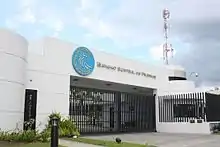
In 2017, the banks in the city numbered around 66, excluding Bangko Sentral ng Pilipinas. The city hosts the regional bank offices of Banco De Oro, Philippine National Bank, Development Bank of the Philippines, Metrobank, RCBC, Allied Bank, China Banking Corporation, Philtrust Bank, UnionBank of the Philippines, Philippine Veterans Bank, Asia United Bank, Maybank, Asia United Bank, Bank of Commerce, East West Bank, Bank of Makati, Bank of the Philippine Islands, and the Philippine Postal Savings Bank.
Shopping malls
SM City Naga is one of the largest and most-visited shopping mall in the Bicol Region. Robinsons Place Naga opened in 2017. Nagaland E-Mall is in Downtown Naga. LCC Central Mall Naga is located on Felix Plazo Street. Gaisano Mall Naga is near the Bicol Medical Center. The Vista Mall is located on Maharlika Highway, in Barangay Del Rosario. There are two Puregold supermarkets in Naga. Avenue Square is the region's first "lifestyle center", built in 2005 along Magsaysay Avenue. There are also leisure hubs in the city, the majority being along Magsaysay Avenue, since that street is the center of nightlife in the region.
IT–Business Process outsourcing
Naga was cited as one of the best places to conduct information technology–business process outsourcing (IT–BPO) activities in the Philippines.[43]
The city currently has three IT parks—Naga City IT Park, Camarines Sur Industrial and Technological Park, and Naga City Technology Center.
IBM leased their own client innovation center in front of SM City Naga.[44]
Culture
Naga is considered to be Bicol's cultural center, due to the largest festival in the region, the Peñafrancia Festival, being held in the city.
Festivals

The Peñafrancia Festival
The city celebrates the feast of Nuestra Señora de Peñafrancia (Our Lady of Peñafrancia), the patroness of the Bicol Region. Starting on the second Friday of September each year, the 10-day feast, the largest Marian devotion in the country. The start of the festival is signalled by a procession (or Translacion) when the centuries-old image of the Blessed Virgin Mary is transferred from its shrine at the Peñafrancia Basilica Minore de Nuestra Señora de Peñafrancia to the 400-year-old Naga Metropolitan Cathedral. Coinciding with nine days of novena prayer at the cathedral, the city celebrates with parades, pageants, street parties, singing contests, exhibits, concerts, and other activities. Finally, on the third Saturday of September, the image is returned, shoulder-borne by so-called voyadores, to the basilica via the historic Naga River. The following day marks the feast day of Our Lady of Peñafrancia, when Pontifical High Masses are celebrated in the basilica, attended by hundreds of thousands of faithful devotees.
Kamundagan Festival
Naga celebrates the Kamundagan Festival every Christmas. It begins with the lighting of the Christmas Village in the Plaza Quezon Grandstand.
Kinalas Festival
Naga celebrates the Kinalas Festival during its yearly anniversary of chartership or cityhood. It honors the most famous local delicacies, kinalas and siling labuyo, with a food contest.
Food and delicacies
Naga is known for some native foods and delicacies.
Kinalas and lug-lug are noodle soup dishes served Bicol style, similar to mami except for a topping of what looked like a pansit palabok sauce, and the meaty dark soup made from boiling a cow's or a pig's head until the flesh falls off. Kinalas is from the old Bicol word kalas,[45][46] which refers to the "fall off the bone" meat that is placed on top of the noodles. The soup is the broth of beef bone and bone marrow (sometimes skull and brain included) or what Manileños call bulalo.[47] The soup is topped with very tender meat slices that also came from the pig's head. It is usually served hot with an egg, and sprinkled with roasted garlic and spring onions. Kalamansi and patis may be added according to taste. Kinalas is usually paired with Baduya, or with Banana or camote cue.
Other delicacies, such as, buko juice, nata de coco, and pan de Naga are found in the city.[48][49]
Sports
The Metro Naga Sports Complex, in Barangay Pacol, has Olympic-sized swimming pools, tennis courts, and a track oval.[50]
The Naga City Coliseum, renamed the Jesse M. Robredo Coliseum in honor of the late DILG secretary and former mayor of Naga, is the largest indoor arena in southern Luzon.
Transportation
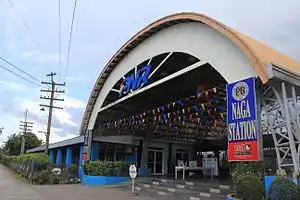
Airport
The city is served by the Naga Airport (WNP) located in Barangay San Jose in the neighboring town of Pili. It has a runway of 1,402 meters (4,600 ft) and thus is capable of handling only small aircraft.
Railways
Naga is the regional head office and the center point of the Philippine National Railway's Bicol Line.
Naga—along with those of adjacent towns and cities, from Tagkawayan, Quezon Province, to Ligao, Albay—is served daily by the Bicol Express. There is a plan for extending the line to Legazpi in the near future.[51]
Roads and bridges
As of December 2009, Naga's total road network is 185.02 kilometers (114.97 mi) in length, of which 147.67 kilometers (91.76 mi) are paved with concrete, 14.63 kilometers (9.09 mi) with asphalt overlay, 4.10 kilometers (2.55 mi) with asphalt, 11.87 kilometers (7.38 mi) are gravel, while 5.76 kilometers (3.58 mi) are dirt. This translates to an increase of 19.74 kilometers (12.27 mi) since 1998.[52]
The city is connected to the capital Manila by the Andaya and Maharlika highways.
In order to spur development in the city, the Toll Regulatory Board declared Toll Road 5 the extension of South Luzon Expressway.[53] A 420 kilometres (260 mi), four-lane expressway starting from the terminal point of the under-construction SLEX Toll Road 4 at Barangay Mayao, Lucena City in Quezon, to Matnog, Sorsogon, near the Matnog Ferry Terminal. On August 25, 2020, San Miguel Corporation announced that they will fund the project, which will reduce travel time from Lucena to Matnog from 9 hours to 5.5 hours.[54]
Public transportation
The most common vehicles used for intra-city travel are public-utility jeepneys (PUJ), trimobiles, and padyaks.
Public utility jeepneys and multicabs, a total of 323 units, are a major mode of intra-city transport used by regular commuters.
Trimobiles are the most famous and most used land transport in the city. There are 1,500 units available for hire while 1,150 are for private use. There is now stiffer competition among drivers, which creates a wide range of problems, such as fare overcharging, refusal to convey passengers, an uneven distribution of trimobile service resulting in a shortage of transport service in some areas of the city, and rampant traffic violations.[52]
Padyaks can be used in subdivision and barangay transportation. They provide a moderate amount of speed for those travelling to the city center.
Inter-town trips are served by 403 filcab vans and 708 jeepneys, while inter-provincial trips are served by an average of 300 airconditioned and non-airconditioned buses and 88 Filcab vans.
Recently, about 50 taxi units became available in the city. They use the new SM Naga City mall as a waiting area for passengers.[52]
Public services
Health care
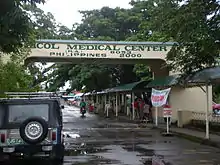
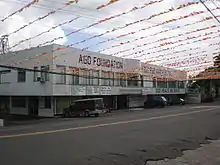
Naga is the medical center of the Bicol Region. It has the largest hospitals in the region. The government-owned Bicol Medical Center and Camarines Sur Provincial Hospital, and the Universidad de Sta Isabel – Mother Seton Hospital, owned and operated by the Daughters of Charity, which are considered the largest hospitals in the region in size and accommodation. The Metropolitan Naga Medical District, in Naga, is the only medical district in Bicol.
Bicol Medical Center (BMC), the largest hospital in the region, is located in Concepcion Pequeña. It offers specialty training in internal medicine, pediatrics, general surgery, obstetric and gynecology, anesthesiology, radiology, ophthalmology, otolaryngology, orthopedics, and traumatology. It is also a base hospital of the Helen Keller Foundation, where eye specialists from all over the country are trained and later assigned to different parts of the Philippines.[55]
Universidad de Santa Isabel - Mother Seton Hospital (USI – MSH), is the largest private hospital in the region by number of admissions, medical equipment facilities, number of beds available, physical structure, and number of board-certified medical consultants. It is the only private hospital in Bicol offering specialty training programs, accredited by the Philippine Medical Association's component society, in major fields of medicine, such as internal medicine, pediatrics, and general surgery.[56]
Camarines Sur Provincial Hospital is another government-owned hospital in the region. It was founded in 1989, by Republic Act 9963, and is one of the first-class hospitals in the Philippines.
The Plaza Medica houses the Naga Endocrine Laboratory (also called the Endolab), a modern hormone laboratory and facility.
Bicol Access Health Centrum is another large hospital located in the city. It houses the Regional Disease Research Center, the first and only in the region.
Several secondary and tertiary hospitals can be found in the city.
Solid waste
The main pollutants in the city come in the form of solid waste generated daily. Generally, these wastes come from various sources: residential, commercial, industrial, and institutional.
Naga generates approximately 85.8 tons of waste per year, based on the latest 2009 estimates, where agricultural waste makes up a little more than one-fourth (26%) of the total volume. Food waste makes up a slightly smaller share, at 23%. Paper-based materials compose 12%, while other categories contribute smaller percentages.
Solid wastes are disposed of and collected via the city's garbage trucks, which traverse ten routes on a daily basis. Collected wastes are then dumped at the dump site in Barangay Balatas, where they are segregated according to type of waste, and whether biodegradable or non-biodegradable.[57][58]
Liquid waste
A study of wastewater treatment facilities is incorporated in the proposed septage management ordinance, where the city will be very strict in forcing compliance with proper waste treatment by housing and establishment owners. The local water-utility agency has made the Metro Naga Water District its local partner in providing septage services, in exchange for adding environmental fees to water bills.
The new wastewater treatment facility of SM City Naga, operational since April 20, 2009, has a capacity of 500 cubic meters per day; but at present, it is treating only around 200.[58]
Fire safety
The Naga City Fire Station is one of the most well equipped fire stations in the country. Other fire stations include Naga Chin Po Tong Fire Brigade, and the Naga White Volunteers.[59]
Police and law enforcement
The city is the location of two of the largest police stations in the Bicol Region. The historic Naga City Police Station, which had been the military base of operations of the Guardia Civil in the region, during the time of Spanish rule.[60][61] Another police office, located in Barangay Concepcion Grande, is the provincial office of the Philippine National Police for Camarines Sur.[62]
Education
Naga is the home of the three largest universities in the Bicol Region. The city is also the home of several colleges.
Tertiary education
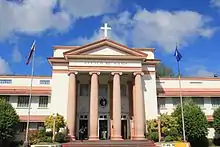
Ateneo de Naga University is a Jesuit university and the largest Catholic university in the Bicol Region. The school has been accredited by PAASCU since 1979 and is the first university in the Philippines to achieve PAASCU Institutional Accreditation, on top of its Autonomous and Level III status. It is a "center of excellence" in teacher education, and a center of development in business administration, entrepreneurship, and information technology. It has produced animators for the country since it launched its bachelor's degree in animation.
The Universidad de Santa Isabel was inaugurated on April 12, 1869, as a private Catholic university owned and run by the Daughters of Charity and is the "first normal school for women in the Philippines and Southeast Asia and the Heritage and Historical University of Bicol".[63][64] It was established by six sisters of the order who arrived in the Bicol Region on April 4, 1868, with the Bishop of Caceres, Francisco Gainza, O.P., the founder of Colegio de Santa Isabel.
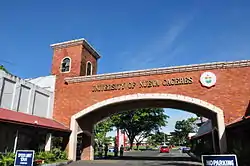
University of Nueva Caceres was the very first university in southern Luzon, and is considered to be largest in the region, due to its attendance and size, that offers courses from kindergarten to graduate school. Founded by Dr. Jaime Hernandez in 1948, it has grown to become one of the leading institutions of higher learning in the Philippines. All course offerings are recognized by the government, and the colleges of Arts and Sciences, Education, and Commerce are accredited by the Philippine Association of Colleges and Universities Commission on Accreditation (PACU-COA). Its College of Engineering and Architecture is now one of the few regional centers for technological education in the Philippines.[65]
Technical colleges in the city include the Bicol State College of Applied Sciences and Technology, Naga College Foundation, AMA Computer University, and STI College.[66][67] Specialized computer schools include Worldtech Resources Institute (WRI), Philippine Computer Foundation College (PCFC), and Computer Communication Development Institute (CCDI).
The country's oldest live-in Christian higher educational institute for the clergy was established in the city in the early part of the 18th century. The Holy Rosary Seminary (El Seminario del Santissimo Rosario), a Roman Catholic seminary run by the Archdiocese of Caceres, has produced 22 bishops, including the first Filipino bishop, Jorge Barlin, and the first Filipino cardinal to work in the Roman Curia, Jose Tomas Sanchez. The seminary has contributed, as well, to the national heritage, through José María Panganiban, Tomás Arejola, and seven of the Fifteen Martyrs of Bicol. On January 29, 1988, the National Historical Institute declared the Holy Rosary Seminary a National Historical Landmark.
Secondary and primary education
The government-run Camarines Sur National High School, which was established in 1902, registers over 10,000 enrollees every school year, and it is the biggest secondary school in the region. Among other secondary schools in the city is the Tinago National High School.
Naga City Science High School was established in Naga in 1994. It has pilot curricula, including the Spanish curriculum, which is the third one in the Philippines, and the journalism curriculum, which allows students to receive training and exposure to college-level situations. The school is consistently a champion at the Doon Po Sa Amin national documentary contest.[68]
Two schools in the city, Saint Joseph School (SJS) and Naga Hope Christian School (NHCS), cater to Filipino-Chinese students.
Naga Parochial School (NPS) is the largest parochial school in the region; it receives 850 enrollees yearly. It is run by priests of the Archdiocese of Caceres. It is the first PAASCU-accredited parochial school in the Philippines. Some members of the clergy (63 as of 2007 with 3 bishops) assigned to the city are alumni of the school. Well-known personalities—such as the late Raul Roco, Jesse Robredo, Francis Garchitorena, Luis R. Villafuerte, Jaime Fabregas, Jonathan Dela Paz Zaens, Archbishop Tito Yllana, and Bishop Jose Rojas—are graduates of NPS.
Private schools—such as Arborvitae Plains Montessori, Inc.; Naga City Montessori School; and the Village Montessori School—can be found in the city. Tutorial and review centers for higher education are also found in the city.
Media
Television networks
All of the major television broadcasting channels' regional offices are located in the city. ABS-CBN Corporation expanded its network in Bicol by establishing ABS-CBN Naga, which operates ABS-CBN channel 11 Naga, ABS-CBN Sports and Action Naga and MOR! Local shows such as TV Patrol Bicol, Marhay na Aga Kapamilya are broadcast throughout the region via ABS-CBN Regional, which is also stationed in the city. TV5 Network Inc.'s TV5 airs shows via channel 22, GMA Network's channel 7 and GMA News TV channel 28 are also available.
Cable and satellite TV
The city's cable and satellite TV companies include South Luzon Cable and DCTV Cable Network Naga (Formerly SkyCable Naga).
Radio stations
Naga has a number of FM and AM radio stations, some of which operate 24 hours daily.
Notable people
- Johnny Abarrientos – a Philippine basketball player who played in the PBA from 1993 to 2010. He is currently serving as coach of the team B-Meg Llamados[69]
- Kyline Alcantara – Filipina actress
- Joker Arroyo[70] – is a statesman and key figure in the EDSA People Power Revolution which evicted then-president Ferdinand Marcos and his family from office. He also served as Congressman of Makati for 9 years, and a member of the Senate for 12 years. Arroyo has received various awards and commendations for his significant contributions to the law profession and public service. Among these are the Philippine Bar Association's Most Distinguished Award for Justice as a "man beholden to no one except to his country" and Senate Resolution No. 100, enacted in the 8th Congress, commending him for his invaluable services to the Filipino people.[71][72][73]
- Wally Bayola – is a Filipino comedian, actor, and TV host of Eat Bulaga!
- Ely Buendia – whose real name is Eleandre Basiño Buendia. He is a Filipino singer, frontman of Eraserheads and Pupil
- Jose Fabian Cadiz – Filipino politician and vice mayor of Marikina City.
- Arnold Clavio – Philippine news anchor
- AJ Dee – whose real name is Angel James Dee III, is an actor and an international competitive swimmer, like his younger brother Enchong Dee.
- Enchong Dee – whose real name is Ernest Lorenzo Velasquez Dee, is an actor, director and model, and an international competitive swimmer. He is a contract artist of ABS-CBN and has won numerous awards for his work in movies and television. He is the younger brother of AJ Dee, also an actor and swimmer. He came to prominence after starring in his first major TV drama Katorse (2009). He played the role of "Luis" in the Filipino remake Maria La Del Barrio (2011). He also starred in Ina, Kapatid, Anak (2012–13), and Muling Buksan Ang Puso.
- Jesse Robredo – is a Filipino statesman and former mayor of Naga. Robredo was able to transform Naga from being dull and lethargic to being one of the "Most Improved Cities in Asia", as cited by Asiaweek Magazine in 1999. During his time in city hall, Robredo was credited for "dramatically improved stakeholdership and people participation in governance, in the process restoring Naga to its preeminent position as the premier city of Bicol Region." In 1995, in recognition of his skills and competence as a leader and development manager, Robredo was elected president of the League of Cities of the Philippines, the national association of city mayors. Robredo also chairs the Metro Naga Development Council. He served as chairman of the Regional Development Council, the regional planning and coordinative body of Bicol's six provinces and seven cities, from 1992 to 1998.
- Leni Robredo – wife of Jesse Robredo, congresswoman of the Third District of Camarines Sur (2013–16), and the incumbent Vice President of the Philippines.
- Raul Roco – was a political figure in the Philippines. He was the standard-bearer of Aksyon Demokratiko, which he founded in 1997 as a vehicle for his presidential bids in 1998 and 2004. He was a then senator and secretary of the Department of Education under the presidency of Gloria Macapagal-Arroyo. He had a strong following among young voters in the Philippines, due to his efforts to promote honesty and good governance.
Image gallery
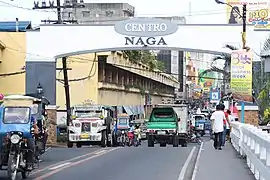 Downtown Naga
Downtown Naga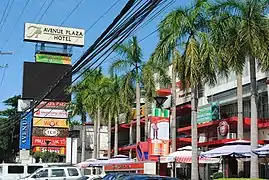 Avenue Square
Avenue Square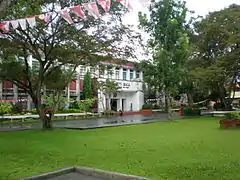 Naga City Hall
Naga City Hall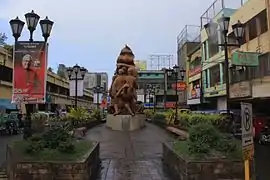 Plaza Oragon
Plaza Oragon Malabsay falls at Mt. Isarog, Panicuason
Malabsay falls at Mt. Isarog, Panicuason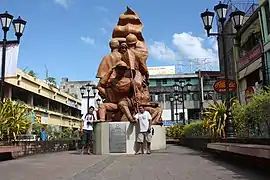 Plaza de Nueva Caceres
Plaza de Nueva Caceres
Sister cities
See also
- List of renamed cities and municipalities in the Philippines
- Roman Catholic Archdiocese of Caceres
- Bicolano People
- List of Bicol Region Cities and Municipalities
References
- City of Naga | (DILG)
- "Welcome to the City of Naga!". Naga City. Retrieved July 7, 2019.
- "Province: Camarines Sur". PSGC Interactive. Quezon City, Philippines: Philippine Statistics Authority. Retrieved 12 November 2016.
- Census of Population (2015). "Region V (Bicol Region)". Total Population by Province, City, Municipality and Barangay. PSA. Retrieved 20 June 2016.
- "PSA releases the 2015 Municipal and City Level Poverty Estimates". Quezon City, Philippines. Retrieved 1 January 2020.
- "The oldest royal city in the Philippines". City Government of Naga Official Website. Retrieved May 19, 2020.
- Perez, Jose B. (February 27, 2015). "Bicol's Boom Town: Bongat sees bullish Naga". Bicol Mail. Archived from the original on April 2, 2015. Retrieved February 13, 2019.
- The Philippine Island World: A Physical, Cultural, and Regional Geography, p. 415, at Google Books
- Orbita, Erlinda Hospicia V. (April 25, 2010). "Naga City, the Heart of Bicol: 'An Maogmang Lugar [The Happy Place]'". The Philippine Star. Archived from the original on April 13, 2014. Retrieved February 24, 2019.
- "Home". Bicol Medical Center. Retrieved February 24, 2019.
- "Bicol Medical Center Modernization". Naga City Deck. Retrieved February 24, 2019.
- "Education". Naga City. Retrieved February 25, 2019.
- Kawanaka, Takeshi (2002). "2. Naga City" (PDF). Power in a Philippine City. Institute of Developing Economies, Japan External Trade Organization (IDE-JETRO). ISBN 978-425852038-1. Retrieved February 25, 2019.
- Bongat, John G. Naga Business Licensing Program (NBLP) (PDF) (Report). Retrieved February 25, 2019.
- Robredo, Jesse M. (May 3, 2000). City Strategy and Governance: The Naga City Experience (PDF). East Asia Urban and City Management Course. Retrieved February 25, 2019.
- "Bongat bares State of City, hails Naga as Bicol's tiger economy". Naga City. Retrieved February 25, 2019.
- "Naga cited as one of [the] most competitive cities". Bicol Mail. August 8, 2013. Archived from the original on September 2, 2013. Retrieved February 25, 2019.
- "Naga City". Philippines Cities. Retrieved February 25, 2019.
- Hermoso, Christina I. (September 13, 2013). "Naga City set for traslacion". Manila Bulletin. Archived from the original on April 29, 2014. Retrieved February 26, 2019.
- Llorin, Jean N. (June 27, 2010). "Learning from 'The Heart of Bicol'". Philippine Daily Inquirer. Archived from the original on June 30, 2010. Retrieved February 27, 2019.
- "Naga City: Where Bicol's heart is". GMA News. September 19, 2012. Retrieved February 27, 2019.
- Abella, D. The Bikol Annals. Manila
- "The Naga We Know to be launched Aug. 31". Likhaan: The UP Institute of Creative Writing. August 26, 2018. Archived from the original on April 13, 2014. Retrieved April 4, 2019.
- G. Nye Steiger, H. Otley Beyer, Conrado Benitez, A History of the Orient, Oxford: 1929, Ginn and Company, p. 122.
- "The First Landings". Retrieved March 18, 2014.
- "R.A. No. 305, Naga City Charter". LawPH.com. 1948. Archived from the original on April 6, 2012. Retrieved January 10, 2019.
- "Protected Areas in Region 5" Archived 2012-03-21 at the Wayback Machine. Protected Areas and Wildlife Bureau. Retrieve don 2012-05-23.
- "General Information". See Naga – Official Website of Naga City. Retrieved on 2012-05-13.
- "Municipality/City: NAGA CITY". PSGC Interactive. Makati City, Philippines: National Statistical Coordination Board. Archived from the original on November 13, 2015. Retrieved April 22, 2014.
- "Total Population by Province, City, Municipality and Barangay: as of May 1, 2010" (PDF). 2010 Census of Population and Housing. Philippine Statistics Authority. Archived from the original (PDF) on November 19, 2012. Retrieved January 7, 2013.
- "Barangay Officials 2010". Naga City. Retrieved April 4, 2019.
- Census of Population and Housing (2010). "Region V (Bicol Region)". Total Population by Province, City, Municipality and Barangay. NSO. Retrieved 29 June 2016.
- Censuses of Population (1903–2007). "Region V (Bicol Region)". Table 1. Population Enumerated in Various Censuses by Province/Highly Urbanized City: 1903 to 2007. NSO.
- "Province of Camarines Sur". Municipality Population Data. Local Water Utilities Administration Research Division. Retrieved 17 December 2016.
- "Demography". Naga City. Retrieved April 4, 2019.
- "Useful Filipino Words – Bicol Translations". Cam Sur Guide Delights. 2012. Archived from the original on April 27, 2014. Retrieved April 4, 2019.
- "Daet, Naga City among most competitive LGUs in 2014". Bicol Standard. 2014. Retrieved April 6, 2019.
- Perez, Jose B. (August 15, 2014). "Naga – PH's 3rd most competitive city; No. 1 in government efficiency". Bicol Mail. Archived from the original on August 26, 2014. Retrieved April 5, 2019.
- Macatangay, Analiza S. (January 2, 2014). "Naga City, among the most competitive LGUs in the country". Philippine Information Agency. Archived from the original on April 16, 2014. Retrieved February 16, 2019.
- "P2.9M ingreso kan bus terminal cada bulan" [P2.9 million for the bus terminal]. Naga City (in Filipino). Retrieved February 13, 2019.
- "South Riverfront Growth Area". City Government of Naga. Retrieved January 12, 2019.
- Atiyah, Jeremy (2002). "Rough Guide to Southeast Asia", pg. 880. Rough Guides Ltd., London. ISBN 1-85828-893-2.
- http://www.curranrecruit.com.au/#!BPO-Hot-spots-in-the-Philippines--looking-beyond-Manila-/c15hi/3CB5CF5C-6C36-44CA-82E0-78C458CE16D9%5B%5D
- "IBM unit to set up BPO facility in Naga City". ABS-CBN News. ABS-CBN Corporation. May 21, 2013. Retrieved April 6, 2019.
- Lisboa, Maŕcos de. "Calas". Vocabulario de la lengua Bicol: compuesto por Maŕcos de Lisboa (in Spanish). p. 89. Retrieved April 8, 2019.
- Lisboa, Maŕcos de. "Hinglas". Vocabulario de la lengua Bicol: compuesto por Maŕcos de Lisboa (in Spanish). p. 181. Retrieved April 6, 2019.
- Naguenian (August 23, 2010). "Kinalas". Blogspot. Retrieved April 8, 2019.
- Gonzalez, Eduardo (January 16, 2013). "The Beneficial Buko Juice". Philippine Council For Health Research And Development. Archived from the original on April 24, 2013. Retrieved April 8, 2019.
- Leah (October 17, 2012). "Pan de Naga (Pugon Pandesal)". The Bright Spot. Retrieved April 22, 2019.
- "Heritage Tour". See Naga. Retrieved on 2012-06-13.
- "Archived copy". Archived from the original on 2013-08-20. Retrieved 2013-09-06.CS1 maint: archived copy as title (link)
- "Transportation". Naga City. Retrieved February 16, 2019.
- "SLEX Toll Road 5 to connect Quezon province to Sorsogon". YugaTech. August 18, 2020. Retrieved January 9, 2021.
- "San Miguel investing P122B for SLEX Toll Road 5, Pasig River Expressway projects". GMA News Online. August 25, 2020. Retrieved January 9, 2021.
- "Bicol Medical Center" Archived 2005-07-27 at the Wayback Machine
- "Universidad de Santa Isabel-Mother Seton Hospital".
- Neola, Jason B. "Solid Waste Management Office created; also named as Special Concerns Office". Naga City. Retrieved February 27, 2019.
- "Waste Management". Naga City. Retrieved February 27, 2019.
- Macatangay, Ana-Liza S. (March 4, 2014). "Naga City kicks off observance of Fire Prevention Month". Philippine Information Agency. Archived from the original on May 12, 2014. Retrieved April 10, 2019.
- "Naga City Police Station". Naga City. Retrieved April 10, 2019.
- http://r05.pia.gov.ph/index.php?article=861357375545%5B%5D
- http://r05.pia.gov.ph/index.php?article=861385550341%5B%5D
- "Formation - Information - Sharing - Prayer... | Filles de la Charité de Saint Vincent de Paul". Retrieved 2019-05-14.
- "CATHOLIC ENCYCLOPEDIA: Sisters of Charity of St. Vincent de Paul". www.newadvent.org. Retrieved 2019-05-14.
- "About UNC". University of Nueva Caceres. 2013. Archived from the original on December 3, 2013. Retrieved April 11, 2019.
- "ACLC College". ACLC College. Retrieved April 11, 2019.
- "STI College - Naga". STI College. Retrieved on 2012-05-13.
- "Naga generates best hometown stories". Smart Communications, Inc. (Press release). February 20, 2014. Archived from the original on March 12, 2014. Retrieved April 11, 2019.
- "Archived copy". Archived from the original on 2014-04-13. Retrieved 2014-04-11.CS1 maint: archived copy as title (link)
- Chua-Eoan, Howard (September 21, 1987). "The Philippines – The Joker Was Not Laughing". Time. Retrieved April 11, 2019.
- Toms, S. "The Philippine name game", BBC News, January 14, 2006. Accessed last February 21, 2007.
- Mydans, S. "Aquino, Under Pressure, Removes Her Closest Adviser", The New York Times, September 18, 1987. Accessed last February 21, 2007.
- Chua-Eoan, H. "The Philippines The Joker Was Not Laughing", Time p. 2, September 21, 1987. Accessed last February 21, 2007.
- "Sister Cities". The Local Government of Quezon City. Archived from the original on 1 October 2017. Retrieved 9 April 2019.
External links
| Wikimedia Commons has media related to Naga City, Camarines Sur. |
| Wikivoyage has a travel guide for Naga City. |
